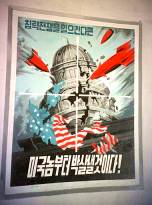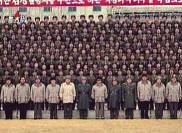|
V RaptureChrist Newsletter
|
||||
Many people are focusing on the threat of Iraq, when a far greater threat exists in North Korea. Calling for a "holy war" against the United States, more than a million people rallied in the North Korean capital of Pyongyang on Saturday January 11, 2003 to support their government's withdrawal from a nuclear arms control treaty. That same day the communist government known as the
Democratic
People's Republic of North Korea escalated its nuclear standoff with
the US. They stated that they would resume the processing of plutonium to build
nuclear weapons as well as building ballistic missiles.  This poster on the left, an AP Photo, is an example of the anti-US propaganda of North Korea. It
depicts three nuclear missiles hitting the US capitol. This poster on the left, an AP Photo, is an example of the anti-US propaganda of North Korea. It
depicts three nuclear missiles hitting the US capitol.
Communist leaders mobilized the huge crowd in Pyongyang a day after North Korea
announced it was quitting the Nuclear Nonproliferation Treaty — a
keystone agreement done in 1968 to stop the spread of nuclear weapons. Other banners called for an "iron hammer blow on U.S. imperialist devils" and "smash U.S. nuclear maniacs." An official exhorted the crowd to chant: "Let's win a holy war against the United States with a military-led might!" Another official encouraged the crowd to repeat "punish the enemy with bloody revenge that we have harbored for 100 years." Other squares, plazas and streets in the North Korean capital were also filled with protesters showing their hatred for the "U.S. imperialists." The anti-American rallies ended with music from military bands. Premier Hong Song Nam said North Korea was resolute to "defend its right to exist from the U.S. imperialists who put an 'axis of evil' cap on us and forced its lackey International Atomic Energy Agency to adopt a resolution to defame the Republic." |
Ten years ago, the director of the CIA, James Woolsey, said to Congress that his greatest worry was North Korea. Hans Blix, director general of the International Atomic Energy Agency at the time, expressed the same concern to the U.N. Security Council. Things have only gotten worse since then. The US government believes North Korea already has two atom bombs ready to be fired by powerful ballistic missiles as well as chemical and biological weapons. North Korea shocked the world in 1998 when it fired a Taepo Dong-1 missile over Japan and into the Pacific Ocean. The government of North Korea excused itself by saying that it was an attempt to launch a satellite. North Korean nuclear engineers are working on the more advanced Taepo Dong-2. US defense believes that this type of missile is capable of delivering a nuclear warhead as far as the continental United States.  North Korea might test the Taepodong-2
missile as early as February 16,
the birthday of the North Korean dictator Kim Jong-il. With
the third largest army in the world, a missile test would boost his prestige at home and
abroad by showing that North Korea is now a nuclear power to be reckoned
with. North Korea might test the Taepodong-2
missile as early as February 16,
the birthday of the North Korean dictator Kim Jong-il. With
the third largest army in the world, a missile test would boost his prestige at home and
abroad by showing that North Korea is now a nuclear power to be reckoned
with.
Exports of ballistic missiles and their technology are one of the North Korea's major sources of hard currency, which allows Kim to continue expanding his missile program. The U.S. government estimates that North Korea received $560 million from missile sales in 2001. The CIA reported that during the last six months of 2001, "North Korea continued to export significant ballistic-missile–related equipment, components, materials and technical expertise to the Middle East, South Asia, and North Africa."  In fact, the Stalinist regime of North Korea has sold
nuclear missile type components to Iran, Libya, Syria and Egypt, according to CIA
sources. There are reports that
Pakistan gave nuclear technology to North Korea in return for information
on how to build guided missiles. In fact, the Stalinist regime of North Korea has sold
nuclear missile type components to Iran, Libya, Syria and Egypt, according to CIA
sources. There are reports that
Pakistan gave nuclear technology to North Korea in return for information
on how to build guided missiles.
In December 2002, a ship from North Korea was seen transporting Scud missiles
to Yemen. The United States was quite concerned. Yemen is a safe-haven for
terrorists, including such groups as the pro-Osama bin Laden Islamic
Jihad.
Many people think that with two or three nuclear missiles North Korea does not pose a threat, but what they do not know is that with one nuclear missile exploded high over the central US, a gigantic Electro-Magnetic Pulse wave is created. The EMP wave would fry all the electronics, especially computer components. The effect is that we would lose all our telephone, television, and radio communications. The US would be blinded in one knock-out blow. |
|||